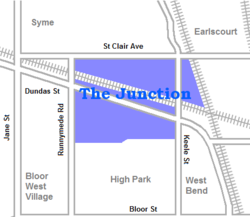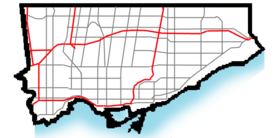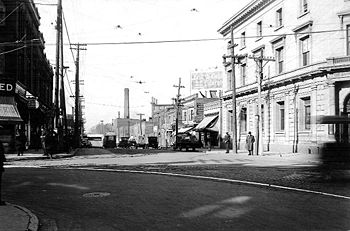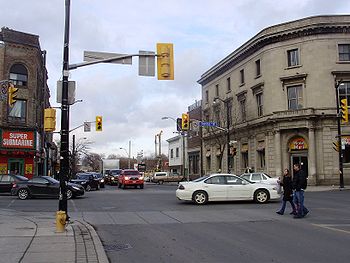- The Junction
-
The Junction — Neighbourhood — Neighbourhood map Location of The Junction within Toronto Country  Canada
CanadaProvince  Ontario
OntarioCity  Toronto
TorontoFounded 1884 Incorporated 1887 (Village) West Toronto Junction
1889 (Town) Toronto Junction
1908 (City) West TorontoAnnexed 1909 into City of Toronto Government - City Councillor Frances Nunziata
Gord Perks
Sarah Doucette- Federal M.P. Peggy Nash
Mike Sullivan- Provincial M.P.P. Laura Albanese
Cheri DiNovoThe Junction is a neighbourhood in Toronto, Ontario, Canada, that is near the junction of four railway lines in the area known as the West Toronto Diamond. The neighbourhood was previously an independent city called West Toronto, that was also its own federal electoral district until amalgamating with the city of Toronto in 1909. The main intersection of the area is Dundas Street West and Keele Street.
Contents
History
As with most Toronto neighbourhoods outside of the central downtown core, the area was primarily rural up until the 1870s. John Scarlett was the first land owner and employer in the area. By 1817 he had acquired most of property that is now The Junction and much more to the north and west to the Humber River. Runnymede Road was built by him and named after his home. From 1857 to 1876 much of the area was the site of the Carlton Race Course which was owned by the Keele family (William Conway Keele and his son Charles Keele). The track was the site of the first Queen's Plate. Following the arrival of the railways in the 1880s, the old racetrack and surrounding area was developed by Daniel Webster Clendenan. The approximate locations of the two main straightaways of the track are now High Park Avenue and Pacific Avenue (between Glenlake Road and Annette Street).
The Village of West Toronto Junction was founded in 1884 at the intersection of Dundas and Keele Streets.[1] In 1889, it merged with the nearby villages of Carlton and Davenport to the north-east to become the Town of West Toronto Junction. It grew further, into the Town of Toronto Junction in 1892, then the City of West Toronto in 1908 before it was amalgamated with the City of Toronto one year later in 1909.
The Junction was a manufacturing community that rose quickly during the late 19th century. Foundries, mills, funiture assembly, meat processing, nail and wire factories were established. Notable companies, such as Canadian Cycle & Motor Co., Campbell Milling Company and the Heintzman piano company set up in the area. Other firms came because land, labour and taxes were cheaper than in Toronto, and the Canadian Pacific established a major operation there, establishing yards from Keele Street as far west as Scarlett Road. In addition, the town acquired an official port of entry in the 1890s, allowing local businesses to clear their goods locally as opposed to using the downtown Toronto port. These factors also attracted many immigrant or second generation Irish Catholics to the area, many of whom moved there from then poor, crowded tenement housing in areas of the city such as Cabbagetown and Brockton Village during the 1880s. Many also came from working-class English industrial cities such as Birmingham and Manchester. They were soon followed by many from non-English speaking countries, including Italians, Poles, Macedonian and Croatian immigrants, many of whom worked in the meat industry.
The Junction was prone to booms and busts during its tumultuous history; while the period between 1888 and 1890 was a prosperous one, the period between 1893 and 1900 saw significant poverty in the area due to an economic recession. The Long Depression saw the closing of factories and the end to construction in the area, and the municipality could not support its citizens because of a large civic debt.
Pubs and taverns became permanent fixtures in The Junction, as was the case with many railway and factory workers' towns. By 1903, alcohol was such a serious problem for families and a public embarrassment (as drunks were visible from passing trains), that a temperance movement grew in the area, led by the strong Methodist community. The town voted to go dry in 1904, and continued to enforce local option as late as 2000, at the time being the last area of Toronto to ban the sale of alcohol.
Toronto annexed The Junction in 1909 and the two have gradually grown together, though residents have retained their community identity and remained very loyal to the neighbourhood, despite further economic hardship. The commercial stretch of Dundas Street went into decline, attributed at least partly to the prohibition. The prohibition law dissuaded restaurants from establishing themselves there, and bars were not permitted.
The area between Keele, Runnymede Road, St. Clair, and the CP railway lines, was for many decades the location of the Ontario Stockyards. For a time, this was Canada's largest livestock market and the centre of Ontario's meat packing industry, and reinforced Toronto's nickname as Hogtown. The Ontario Stockyards closed at this site in 1993 (moving to Cookstown, much further north of the city), and most of the meat-packing plants that surrounded it closed shortly thereafter. Much of the lands has been redeveloped with new housing and retail uses. The main Stockyards site is now the location of a large bloc of big-box stores, including Metro, Home Depot, Canadian Tire, Future Shop and Rona, along with several smaller stores. There are still some smaller meat-packing facilities in the area and the name "Stockyards" is still used for the area.
Since the early 1920s, the area by Dundas and St. John's Road has been known as "Little Malta" (getting signs to that effect in the 1990s) with several Maltese-Canadian businesses present, as well as a distinctly Maltese church. The Maltese-Canadian community has partially spread out to Mississauga and other Toronto suburbs, but still has a visible presence in this area.[2]
As a consequence of the local abattoirs and other industries which produced volumes of toxic waste, the residents of the neighbourhood are highly concerned about pollution issues, and the city of Toronto has put significant efforts into cleaning up former industrial sites.
The elimination of prohibition has had a positive effect on the community, however. Rapid gentrification has meant new chic restaurants and bars have opened up along Dundas Street, attracting young hipsters, while lower rents make the neighbourhood appealing to artists. Some see The Junction as the next big "hip place to live" with a surplus of vacated industrial space and warehouse loft conversion possibilities.
In 2009 the West Toronto RailPath opened, providing a direct link for pedestrians and cyclists from The Junction to the Dundas and Lansdowne area. There are plans to eventually extend the path further south to the Liberty Village neighbourhood.
Boundaries
Today, the term "The Junction" is generally applied to the area north of Annette, south of St. Clair, and between Runnymede Road and the Canadian National Railway corridor to the east which intersects with the Canadian Pacific Railway corridor at West Toronto Diamond. Historically, the boundary lines cover a considerably larger area.[3] The City of West Toronto as annexed by Toronto in 1909 had a northern boundary well past St. Clair to Rowntree Avenue, an eastern boundary zig-zagging along the Canadian National tracks, a southern boundary of Bloor Street, and a western boundary as far as Jane Street in the southwest between Bloor and Annette [1]. Since the 1920s[citation needed], the commercial development on Bloor Street has caused the area between The Junction and Swansea to rise in prominence, and thus many current residents of the former Junction area identify more with Runnymede-Bloor West Village.
Events
The Junction hosts a variety of public events during the year including:
- The Junction Arts Festival (September, cancelled for 2011).
- Participates in the Toronto city-wide Contact Photography Festival (May)
- Participates in the Toronto city-wide Cavalcade of Lights (December)
Schools
- Annette Street Public School - A public elementary school located at 265 Annette Street. The original east building was constructed in 1886 and the west wing was added in 1960. The school shares the facilities (including the library, gym, pool and playground) with High Park Alternative School. It also shares space with The Junction Daycare and the Toronto Parks and Recreation Department.
- High Park Alternative School - A public elementary school sharing space in the Annette Street Public School, it was founded in 1981. The school has grown from its original 3 classrooms to its current 7 classrooms. It is committed to:
- family involvement in all aspects of the school
- small school environment
- non-competitive environment and evaluation
- multi-age grouping
- community-based curriculum
References
- ^ "A Brief History of the Junction". West Toronto Junction Historical Society. 2005-11-26. http://www.wtjhs.ca/history.htm. Retrieved 2007-01-09.
- ^ Micallef, Shawn (2005-06-30). "The Maltese have moved away from Little Malta, but their culture remains". Eye Weekly. http://www.eye.net/eye/issue/issue_06.30.05/city/littlemalta.php. Retrieved 2006-12-19.
- ^ Raymond L. Kennedy. "The Junction and Its Railways". http://www.trainweb.org/oldtimetrains/Toronto/junction/history.htm. Retrieved 2009-09-27.
External links
Community groups
- The Junction Arts Festival
- The Junction Forum for Art and Culture the non-profit organization which presents the Junction Arts Festival.
- The Junction Business Improvement Area
- The West Toronto Junction Historical Society maintains archives of historical documents, pictures and other interesting information about this neighbourhood's rich past.
- The West Bend Community Association
- Junction Residents Association
Historical photos
Neighbourhood profiles
Coordinates: 43°39′56″N 79°27′52″W / 43.66556°N 79.46444°W

Rockcliffe-Smythe (York) 
Runnymede 
Carleton Village  The Junction
The Junction 

Bloor West Village High Park North Junction Triangle Former municipalities of Toronto by year of amalgamation 1883-1912 1883: Yorkville · 1884: Brockton · Riverdale · 1888: Seaton Village · 1889: Parkdale · 1890: Bedford Park · Davisville · 1905: Rosedale · 1908: Deer Park · East Toronto · 1909: Bracondale · West Toronto · Wychwood · 1910: Moore Park · North Toronto · 1912: Dovercourt · Earlscourt1967 1998 Categories:- Neighbourhoods in Toronto
Wikimedia Foundation. 2010.






